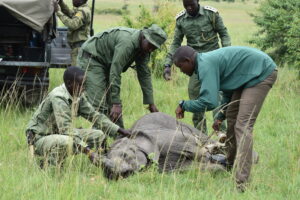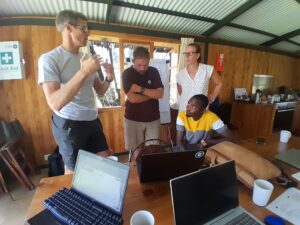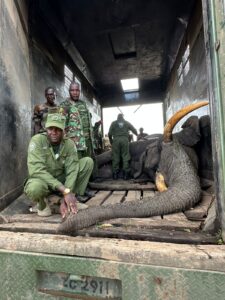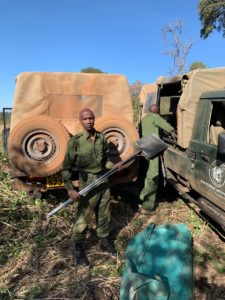
The headline for the month of March was most definitely the fire in the Mau Forest. The Sheldrick Wildlife Trust (SWT) Mau De-Snaring Unit was first on the scene and first to report the fire and the MEP rapid response unit was sent in with over 50 fire beaters to combat the eight fires that were burning at one point in the middle of March. Kenya Forest Service (KFS) were critical in helping MEP contain everything at first and mother nature was luckily on our side with some rain coming in by the end of the month to extinguish all existing fires.
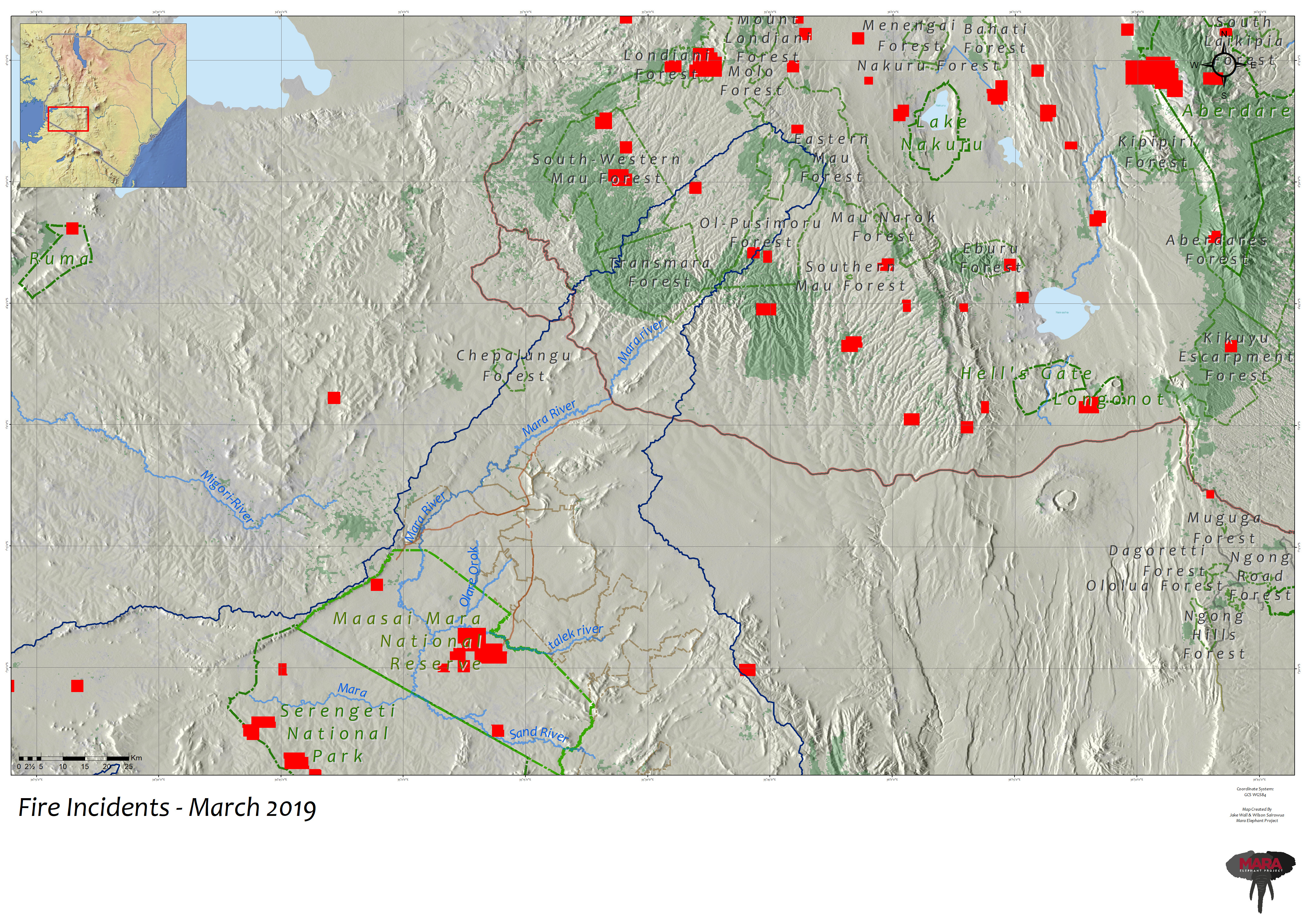 Starting in March, MEP added a fire burn area map to the environmental section of the monthly report. Red blocks indicate burn areas and you can see the fires that threatened the Mau Forest.
Starting in March, MEP added a fire burn area map to the environmental section of the monthly report. Red blocks indicate burn areas and you can see the fires that threatened the Mau Forest.
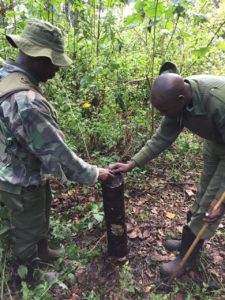
The problem with the Mau is the illegal logging that is continuing in the forest. The secondary forest had a lot of the dead wood remaining from the past logging activities, which just added fuel to the fire. In March alone, the SWT Mau De-Snaring Unit destroyed two charcoal kilns and arrested three suspects for actively logging illegally inside the Mau Forest. MEP Senior Warden James Ekiru started March off with the SWT Mau De-Snaring Unit and they were responsible for the removal of eight snares and one drop spear targeting elephants. To bring light to this critical area, MEP celebrated World Wildlife Day on March 3 by publishing a blog about the Mau Forest and how it tied into the 2019 theme of protecting life below water. The interconnectedness of the forests, savannas and rivers in Kenya is always at the forefront of MEP’s mission. When we protect elephants, as an umbrella species, and the habitats upon which they depend, there is a trickle-down effect for every living thing.
There was an arrest of two suspects in March by Kenya Wildlife Service (KWS) based on MEP intelligence in possession of 3 kg of ivory and hippo and warthog teeth (pictured below). MEP rangers also assisted the KWS Vet Dr. Limo from the SWT Mara Mobile Vet Unit in two elephant treatments in March, both occurring in Olarro Conservancy.
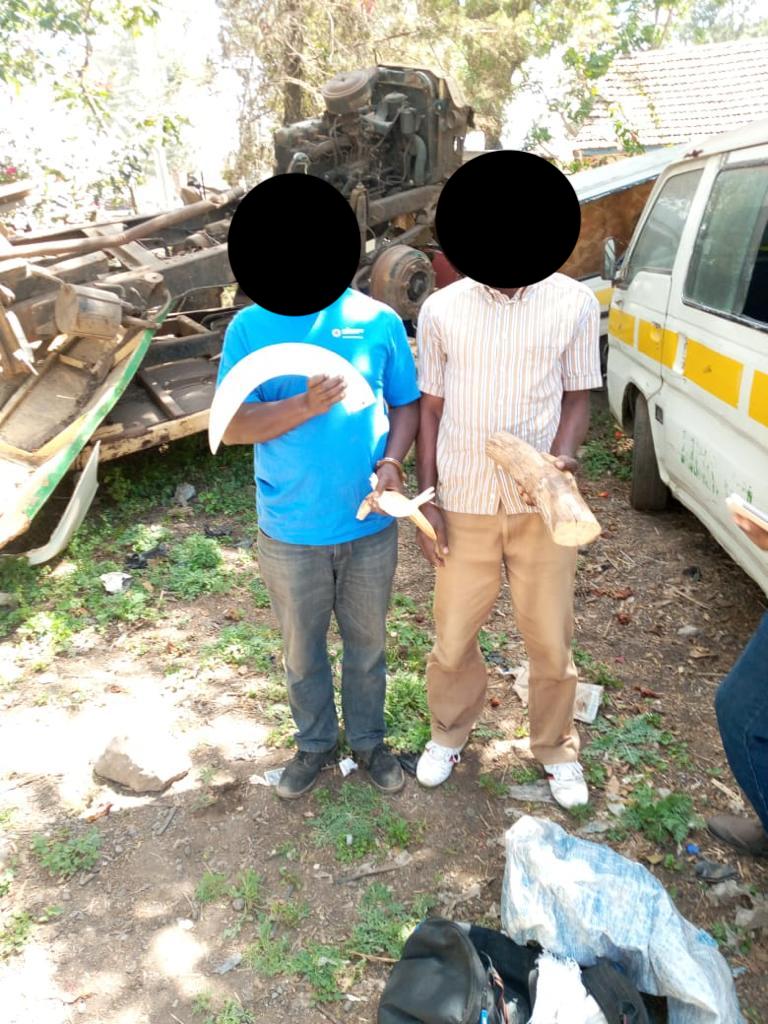
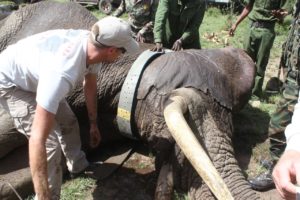 Dr. Limo also assisted MEP in the re-collaring of elephant Lempiris. On February 18, MEP collared elephant Lempiris’ collar stopped reporting. Rangers nearby his location were sent with a VHF tracker to try and locate his collar and found it had stopped working due to hardware failure. Though the collar needed to be exchanged for a newer model, we were happy to see that Lempiris was in good health. Lempiris is a large adult bull elephant that was originally collared by MEP on the 10thof November 2017 in response to an increase in human-elephant conflict along the border of Olarro Conservancy. Since Lempiris was in a high human-elephant conflict area, it was vital that we continued to gather movement data on him so rangers could respond in real-time to help save communities. Additionally, his movement data helped MEP define a northern corridor when he travelled in 2018 all the way to the Mosiro escarpment. That’s why on March 10, with the approval of KWS, MEP re-collared Lempiris in Olarro Conservancy. Olarro Conservancy rangers partnered with MEP during this operation and Lempiris was fitted with a brand-new Kevlar collar and an arrow wound was treated on his right rear leg. The operation went very well and Lempiris’ new collar is reporting with zero issues. pictured left: Dr. Jake Wall collaring Lempiris.
Dr. Limo also assisted MEP in the re-collaring of elephant Lempiris. On February 18, MEP collared elephant Lempiris’ collar stopped reporting. Rangers nearby his location were sent with a VHF tracker to try and locate his collar and found it had stopped working due to hardware failure. Though the collar needed to be exchanged for a newer model, we were happy to see that Lempiris was in good health. Lempiris is a large adult bull elephant that was originally collared by MEP on the 10thof November 2017 in response to an increase in human-elephant conflict along the border of Olarro Conservancy. Since Lempiris was in a high human-elephant conflict area, it was vital that we continued to gather movement data on him so rangers could respond in real-time to help save communities. Additionally, his movement data helped MEP define a northern corridor when he travelled in 2018 all the way to the Mosiro escarpment. That’s why on March 10, with the approval of KWS, MEP re-collared Lempiris in Olarro Conservancy. Olarro Conservancy rangers partnered with MEP during this operation and Lempiris was fitted with a brand-new Kevlar collar and an arrow wound was treated on his right rear leg. The operation went very well and Lempiris’ new collar is reporting with zero issues. pictured left: Dr. Jake Wall collaring Lempiris.
Unfortunately, Wilbur’s collar stopped reporting on the 25thof March. This was especially frustrating as the week before the Mau Forest rangers were able to find him and his herd of 40 safely avoiding the fires. After the collar stopped reporting they were sent to find his location but were unable to do so because of the thick vegetation. We’re continuing to look for him and his herd.
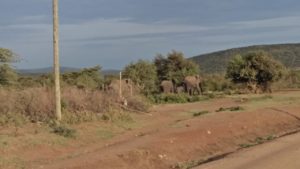
There were nine human-elephant conflict incidents in March. Most involved elephants breaking into fences (pictured left) or crops and all were responded to by MEP rangers using their vehicle, motorbikes and firecrackers. Most important to MEP is not just the mitigation of human-elephant conflict, but the long-term solutions for it, one being next generation education.
In March, MEP participated in Twende Porini or Let’s Go Wild, Asilia Africa’s flagship yearly environmental and community program in the Mara where local kids won a contest to spend four nights at Asilia’s Rekero Camp learning about conservation in creative ways. MEP Administrator Elvis Saayoi was in attendance and presented about the work MEP is doing in their own communities to mitigate human-elephant conflict. They were taken to see MEP collared elephant Hugo and taught about how the collars on elephants are helping MEP intervene when elephants are entering communities. It’s experiences like these that can change the course of a young person’s life and participation in contests like this are very important for MEP to ensure we are encouraging the future generation of Kenyans to be the leaders on conservation.
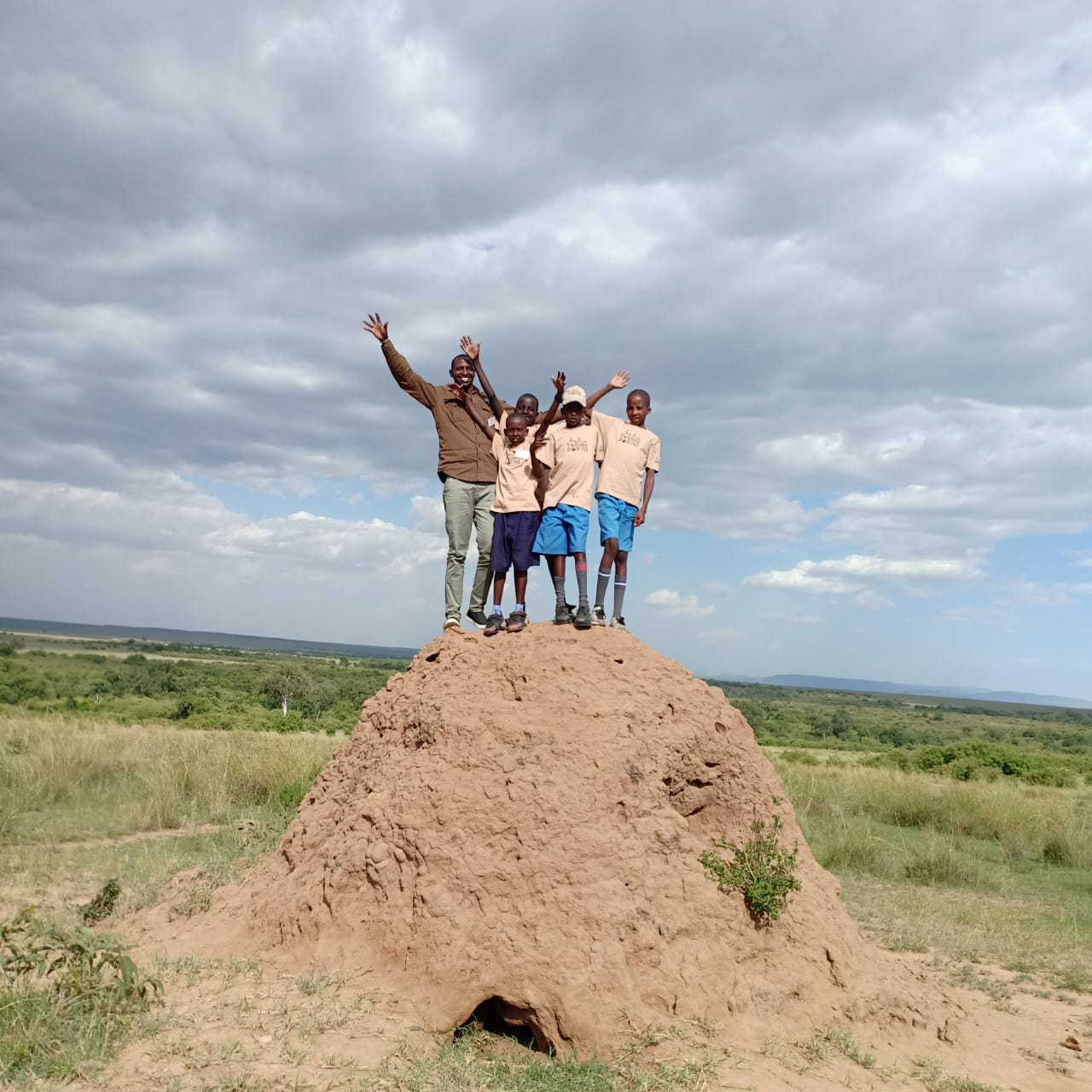 MEP Administrator Elvis Saayoi with kids participating in Twende Porini.
MEP Administrator Elvis Saayoi with kids participating in Twende Porini.
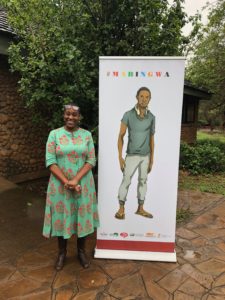 MEP Director of Research and Conservation Dr. Jake Wall attended an AfriMov workshop the week of March 25 in Tanzania that was funded by a grant received by Grant Hopcraft and Tom Morrison at the University of Glasgow. The goal of the workshop was to consolidate movement data on African species into a single database and then ask general questions – i.e., compare & contrast the movements of animals across species and regions. One of the many good discussions that came from this workshop was on spatial data layers which are essential to movement ecology analyses and solutions for creating a central point for the data. It was announced in the first of March that MEP Trustee Beatrice Karanja (pictured right) was appointed to the judging panel of the annual TUSK Conservation Awards. This is a very prestigious appointment and we congratulate her on this amazing success! Read more about Beatrice’s appointment here. In other trustee news, MABINGWAa film executive produced by MEP Trustee Trey Fehsenfeld was awarded the Award of Distinction from the Best Shorts Competition 2018 Humanitarian Awards. MABINGWA was hand selected by the judges and staff, from the entire pool of entries to the competition throughout 2018, as a film that represents both the spirit of humanitarianism combined with quality filmmaking craft.
MEP Director of Research and Conservation Dr. Jake Wall attended an AfriMov workshop the week of March 25 in Tanzania that was funded by a grant received by Grant Hopcraft and Tom Morrison at the University of Glasgow. The goal of the workshop was to consolidate movement data on African species into a single database and then ask general questions – i.e., compare & contrast the movements of animals across species and regions. One of the many good discussions that came from this workshop was on spatial data layers which are essential to movement ecology analyses and solutions for creating a central point for the data. It was announced in the first of March that MEP Trustee Beatrice Karanja (pictured right) was appointed to the judging panel of the annual TUSK Conservation Awards. This is a very prestigious appointment and we congratulate her on this amazing success! Read more about Beatrice’s appointment here. In other trustee news, MABINGWAa film executive produced by MEP Trustee Trey Fehsenfeld was awarded the Award of Distinction from the Best Shorts Competition 2018 Humanitarian Awards. MABINGWA was hand selected by the judges and staff, from the entire pool of entries to the competition throughout 2018, as a film that represents both the spirit of humanitarianism combined with quality filmmaking craft.
MEP Monthly Report March 2019
For a second year in a row, Crooked Creek Elementary School in Indianapolis, IN held their Global Marketplace to benefit MEP. Kids hand crafted items to sell to students, teachers and staff with 100% of the proceeds donated to MEP. MEP had one Facebook Fundraiser in March run by Jade who out did her goal of £100 and raised £162 pounds for MEP! Thank you for choosing to celebrate your birthday with MEP and thank you to everyone who donated to MEP in March on Facebook, we received $323.80 in donations. DJI released the video they produced while visiting MEP in February and directly encouraged donations on their various social media channels to MEP. We would like to thank Brett Velicovich and the folks at DJI for making this happen. As a result of this and a generous donation by a new supporter, MEP had $4,124 in PayPal donations in March.The Explorations Company included Mara Elephant Project as part of their ecotourism package for 2019. Additionally, they’ve included us on their website as a project that they support and encourage their travelers to support as well. We had four visits in March to MEP HQ from Saruni Mara, Kicheche and Richard’s Camp and we thank these camps for including MEP in their Mara itineraries. The final visit was from a delegation of US Congress people who were in Kenya representing USAID. MEP CEO Marc Goss hosted them at HQ and presented them with compelling evidence that the Mara should be included in the USAID considered funding. Finally, the Greatest Maasai Mara photo competition continues to have great March entries benefitting MEP.
